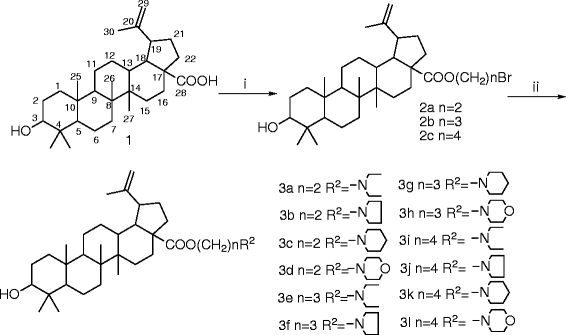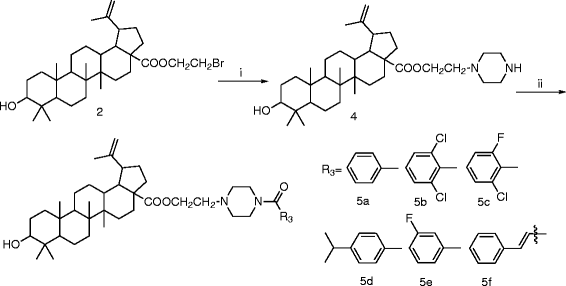Design, synthesis and biological evaluation of novel betulinic acid derivatives
- PMID: 23174002
- PMCID: PMC3541990
- DOI: 10.1186/1752-153X-6-141
Design, synthesis and biological evaluation of novel betulinic acid derivatives
Abstract
Background: Tumor, is one of the major reason for human death, due to its widespread occurrence. Betulinic acid derivatives have attracted considerable attention as cancer chemopreventive agents and also as cancer therapeutics. Many of its derivatives inhibit the growth of human cancer cell lines by triggering apoptosis. With this background, we planned to synthesize a series of betulinic acid derivatives to assess their antiproliferation efficacy on human cancer cell lines.
Results: A series of novel betulinic acid derivatives were designed and synthesized as highlighted by the preliminary antitumor evaluation against MGC-803, PC3, A375, Bcap-37 and A431 human cancer cell lines in vitro. The pharmacological results showed that some of the compounds displayed moderate to high levels of antitumor activities with most of new exhibiting higher inhibitory activities compared to BA. The IC50 values of compound 3c on the five cancer cell lines were 2.3, 4.6, 3.3, 3.6, and 4.3 μM, respectively. Subsequent fluorescence staining and flow cytometry analysis (FCM) indicated that compound 3c could induce apoptosis in MGC-803 and PC3 cell lines, and the apoptosis ratios reached the peak (37.38% and 33.74%) after 36 h of treatment at 10 μM.
Conclusions: This study suggests that most of betulinic acid derivatives could inhibit the growth of human cancer cell lines. Furthermore, compound 3c could induce apoptosis of cancer cells.
Figures







Similar articles
-
Synthesis and in vitro antitumor evaluation of betulin acid ester derivatives as novel apoptosis inducers.Eur J Med Chem. 2015 Sep 18;102:249-55. doi: 10.1016/j.ejmech.2015.08.004. Epub 2015 Aug 5. Eur J Med Chem. 2015. PMID: 26280921
-
Synthesis and biological evaluation of betulonic acid derivatives as antitumor agents.Eur J Med Chem. 2015;96:58-65. doi: 10.1016/j.ejmech.2015.04.006. Epub 2015 Apr 4. Eur J Med Chem. 2015. PMID: 25874331
-
Synthesis and in vitro antitumor activity of (1E,4E)-1-aryl-5-(2-((quinazolin-4-yl)oxy)phenyl)-1,4-pentadien-3-one derivatives.Chem Cent J. 2017 Mar 15;11:23. doi: 10.1186/s13065-017-0253-9. eCollection 2017. Chem Cent J. 2017. PMID: 28360932 Free PMC article.
-
Betulinic Acid and its Derivatives as Potential Antitumor Agents.Med Res Rev. 2015 Nov;35(6):1127-55. doi: 10.1002/med.21353. Epub 2015 Jun 2. Med Res Rev. 2015. PMID: 26032847 Review.
-
Recent progress on betulinic acid and its derivatives as antitumor agents: a mini review.Chin J Nat Med. 2021 Sep;19(9):641-647. doi: 10.1016/S1875-5364(21)60097-3. Chin J Nat Med. 2021. PMID: 34561074 Review.
Cited by
-
Comparison of In Vitro Antimelanoma and Antimicrobial Activity of 2,3-Indolo-betulinic Acid and Its Glycine Conjugates.Plants (Basel). 2023 Mar 9;12(6):1253. doi: 10.3390/plants12061253. Plants (Basel). 2023. PMID: 36986941 Free PMC article.
-
Recent Developments in the Functionalization of Betulinic Acid and Its Natural Analogues: A Route to New Bioactive Compounds.Molecules. 2019 Jan 19;24(2):355. doi: 10.3390/molecules24020355. Molecules. 2019. PMID: 30669472 Free PMC article. Review.
References
-
- de Melo CL, Queiroz MGR, Filho ACV, Rodrigues AM, Sousa DF, Almeida JG, Pessoa OD, Silveira ER, Menezes DB, Melo TS, Santos FA, Rao VS. Betulinic acid, a natural pentacyclic triterpenoid, prevents abdominal fat accumulation in mice fed a high-fat diet. J Agric Food Chem. 2009;57:8776–8781. doi: 10.1021/jf900768w. - DOI - PubMed
-
- Fujioka T, Kashiwada Y, Kilkuskie RE, Cosentino LM, Ballas LM, Jiang JB, Janzen WP, Chen IS, Lee KH. Anti-AIDS agents, 11. Betulinic acid and platanic acid as anti-HIV principles from Syzigium claviflorum, and the anti-HIV activity of structurally related triterpenoids. J Nat Prod. 1994;57:243–247. doi: 10.1021/np50104a008. - DOI - PubMed
-
- Nguemfo EL, Dimo T, Dongmo AB, Azebaze AG, Alaoui K, Asongalem AE, Cherrah Y, Kamtchouing P. Anti-oxidative and anti-inflammatory activities of some isolated constituents from the stem bark of Allanblackia monticola Staner L.C (Guttiferae) Inflammopharmacolocgy. 2009;17:37–41. doi: 10.1007/s10787-008-8039-2. - DOI - PubMed
-
- Onwuchekwa C, Oluwole FS. Anti-gastric ulcer and anti-inflammatory properties of betulinic acid in male albino rats. Sci W J. 2010;5:15–17. - PubMed
LinkOut - more resources
Full Text Sources

